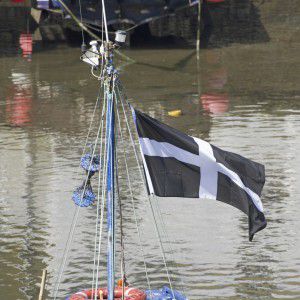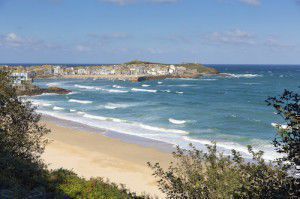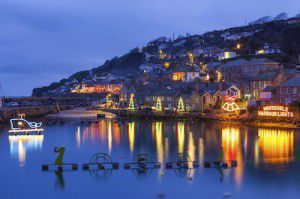Tell us about your Tartan…
We were disappointed recently to find that – somehow – we had missed National Tartan Day. I know! We’ll do better next year.
Although you might think National Tartan Day is a Scottish endeavour, it actually stems from North America and seems to have developed into rather a massive Celtic festival. Which leads us to wonder, what exactly is tartan and why is it so important?
When we think of tartan, we generally think of a woven patterned cloth which belongs to a particular Scottish clan. Most clans will tend to have both a dress and hunting tartan, the hunting tartan being a sombre version made up of dark colours whilst the dress usually swaps a colour from the pattern out for white, making it much brighter. There is a lot of etiquette around tartan, and I for one would not try to wear a tartan that I had no connection with, sticking instead to the tartans from my family’s history.
Or, I might wear a Cornish tartan, because in recent times tartan has become increasingly used by regions, ethnicities and businesses. Cornwall’s tartan was created in the 1960s and has really caught on, being widely available on tourist knick-knacks and formal clothing. At a wedding I recently attended, the groom and best men were all wearing Cornish tartan waistcoats, and the Cornish tartan kilt is not an unusual site at a festival. What is perhaps especially nice about this regional tartan is that anyone Cornish is entitled to use it- there’s no difficulty in etiquette- and even if you’re not Cornish but want to celebrate Cornwall, you’re more than welcome to help yourself to some Cornish tartan, as long as you can stand the slightly weird and bright mustard yellow of it…

If you want to wear tartan but don’t really feel a particular affiliation with a particular clan, then a good option for British and Commonwealth citizens is the Hunting Stewart tartan which, being Queen Elizabeth II’s personal tartan, can be used by all of her subjects. The other good option is Black Watch, also known as Government Tartan, which is traditionally available to those who don’t have a tartan of their own.
Do you have a particular tartan you wear, or thoughts on tartan etiquette? We’d love to hear from you!
Nat
Kernow Bys Vyken!
It’s not often you hear the Cornish language spoken in the streets of London. To be honest, it’s not often you hear it in the streets of Cornwall, although I promise it does happen, if you know where to look.
But this weekend was an exception, because Saturday was St Piran’s Day, the national day of Cornwall, and London was celebrating in style with its annual Shoreditch celebration, Kernow In The City.
So what’s it all about?
Drinking heavily!
No, I’m joking, of course – in fact, I find St Piran’s Day is one of the more sober Cornish celebrations, as it’s really more about celebrating the culture of Cornwall. Back home, different towns have different traditions, but usually there’ll be music and singing, a parade of some sort, perhaps some dancing and dressing up, occasionally a pasty competition. In Westminster, the Cornish MPs hold a cultural reception which aims to teach more about Cornwall’s identity and culture.
The Shoreditch evening event, which I’ve been going to for a good 4 or 5 years, is also primarily a cultural celebration, with different Cornish talent every year and a heavy focus on music (this year featured the amazing Flats and Sharps as the grand finale, last year saw The Oggymen taking centre stage), as well as a variety of comedians (The Kernow King has been guest of honour in the past, and still usually makes a remote appearance via video).
But get a lot of pining ex-pat Cornish together and a few kegs of Betty Stogs beer and it will inevitably turn into a somewhat tipsy affair, with plenty of drunken dancing by the end of the evening. And that’s part of the reason I love Kernow In The City: every year I take along a few non-Cornish people, who tentatively agree to attend in the full expectation of being hounded out of the venue for being English, and although some of the in-jokes about miniature Cornish villages do go over their heads, and the bilingual compering leaves plenty to be understood, by the end of the evening they’re usually bellowing out the words to Trelawney (our national anthem) with great passion, and dancing with total strangers.
Nothing could do more to dispel the myth of the Cornish cold shoulder than the St Piran’s Day event: take a small interest in Cornish culture and you really will be welcomed with open arms. Learn a couple of words of Cornish and you’ll be the talk of the town. And if you’re going to learn anything, learn these three words: Kernow Bys Vyken (Cornwall For Ever), a toast to make you Cornish friends for life.
Proper job!
Nat
Way, Haul Away… Sea shanties and language learning
Last weekend, I spent a very merry, slightly tipsy few days at the International Sea Shanty Festival in Falmouth.
International What, now? Allow me to explain.
 Every year, Falmouth town hosts a three-day festival of nautical songs and chants, to which people flock not only from all over Cornwall, but from foreign parts too – Ireland, Brittany, England, even America. Every B&B, campsite and hotel is full to the brim with shantymen (and, increasingly, some shantywomen!), and the streets swarm with be-smocked musicians and the occasional pirate. Nearly every pub (of which Falmouth has a very generous range) becomes a venue for the various shanty bands, who also play on street corners, outside shops and in the public squares.
Every year, Falmouth town hosts a three-day festival of nautical songs and chants, to which people flock not only from all over Cornwall, but from foreign parts too – Ireland, Brittany, England, even America. Every B&B, campsite and hotel is full to the brim with shantymen (and, increasingly, some shantywomen!), and the streets swarm with be-smocked musicians and the occasional pirate. Nearly every pub (of which Falmouth has a very generous range) becomes a venue for the various shanty bands, who also play on street corners, outside shops and in the public squares.
Each hour, a venue’s lineup changes, and you’ll see canvas smocks in Breton red, navy blue and stripes scurrying from one establishment to another as they get ready to set up for their next gig. Every year, I make elaborate plans to switch venue every hour to see all the bands I want to see, but inevitably the beer in one pub ends up being unusually good, and a seat becomes vacant, and 7 hours later you find that somehow you’re still in the same venue and 7 different bands have floated on and off stage before your eyes, whilst old-timers have come and shared your table and had a natter about… well, everything under the sun. Which is all very much in the spirit of the festival.
So what is a shanty?
Most people think the name ‘shanty’ comes from the French ‘chanter’ (to sing). Although there’s some debate about this, what’s definite is that a shanty is a traditional form of song sung by sailors, which aims to reflect the rhythm of the work on deck (hauling halyards, pulling the anchor, setting jibs, winding a capstain). Often, a lead shantyman will give the ‘call’ and then the other crew will give the ‘response’ (short, sharp calls and responses for the jobs requiring bursts of energy; longer, more lyrical ones for the slower jobs). Working shanties often feature the nature of the work itself as the main theme – ‘Haul Away Joe’, ‘Wey, hey, blow the man down!’ – but for those lonely evenings or periods of comparative calm, there are the wistful shanties which recall the shore and all its comforts – ‘Spanish Ladies’, ‘Maggie May’ – and remind the young sailors of their sweethearts left behind (often including a not-so-veiled warning about what said sweethearts are most likely getting up to with other boys whilst their sailors are at sea).
Who sings shanties nowadays?
There are plenty of shanty bands around the country – and the world. This weekend alone, I saw bands from Falmouth, Treverva, Salisbury (not a lot of sea in Salisbury, but there you go), Brittany, Exmouth, Holland, Poland, Yorkshire, and plenty more places. Some are professional groups with regular gigs of their own, whilst others are more casual affairs – people who just love to shant!
What’s all this got to do with language?
I’m glad you asked. The thing is that although shanties get sung in all sorts of languages and dialects, you never, ever feel left out by not understanding the words. Turn up to one of the Breton bands and (unless you speak Breton or Cornish), you probably won’t have a clue what the words mean, but you’ll definitely understand the spirit of it, and before long you’ll find yourself singing along to the chorus, arm in arm with everyone else. In part, this is because shanties are very repetitive by nature, so it’s easy to pick up on lyrics and sing along.
All of which makes me think that singing has got to be a great way to pick up a new language – and any type of song will do! Nursery rhymes, pop songs, national anthems, folk songs, poems, choral music, raps; it all helps, it really does. I still remember all the Zulu words to ‘Siyahamba’, which Safia and I learned over just a few days (video evidence below). And even if you don’t know exactly what all the words mean to begin with, it’s a huge encouragement to be able to fluently reel off a couple of sentences in your new language, all learned through song.
…Way, Haul Away,
We’ll Haul Away, Joe!
Nat
Time to say ‘Dyw genes’ to Poldark
I don’t know about you, but here at EuroTalk we’ve been very much enjoying the BBC’s latest Sunday night drama, Poldark. Set in the late 18th century, and based on the books by Winston Graham, it’s the story of Ross Poldark (Aidan Turner), who returns from the American War of Independence to find his father dead and the woman he loves engaged to his cousin. Poldark is an epic love story, with a suitably dashing hero, but it’s also a historical drama about the business and politics of the mining industry in south west England. I can’t speak for its accuracy, but it’s definitely very enjoyable…
Poldark is set on the beautiful coast of Cornwall, and with the series finale airing this weekend, we thought it was only right that we say an appropriate farewell. So whether you’ve always fancied learning a little Cornish, or, like us, you’re a fan of the lovely Ross, here’s your chance.
How did you do?
Want an opportunity to try out what you’ve learnt? Read Nat’s post on 10 reasons to visit Cornwall.
And if you haven’t had a chance to enjoy Poldark, and you’re wondering what all the fuss is about, check out the trailer.
10 reasons to visit… Cornwall
With St Piran’s Day approaching fast, what better time for a blog post on why to visit lovely Cornwall? Despite the occasionally severe weather and lack of phone signal, everyone who’s ever been to Cornwall seems to love it, and here (in my opinion) is why:
1. The Isles of Scilly
Situated 30-odd miles off the mainland, this archipelago boasts its own microclimate of tropical plants and pearl-white beaches. A network of ferries connect the inhabited (and some of the uninhabited) islands, making daily dashes across the turquoise waters. If you’re there for a week, it’s worth taking a new ferry trip each day, as all the islands have quite different scenery, but if you’re just on a day trip from the mainland you might want to join the crowds in the Tresco Abbey Gardens, a stunningly maintained collection of exotic plants in a vibrant setting. Don’t forget to meander down to the corner of the Gardens know as ‘Valhalla’, where you will find a graveyard of figureheads salvaged from Scilly wrecks.
2. Pasties
I just said that to get your attention: although the Cornish Pasty is definitely a wonderful creation, and a very famous Cornish export, it’s by no means the only food on offer. Try to sample some other local delicacies during your trip, such as saffron cake, clotted cream (preferably in the form of a cream tea), Yarg cheese, mead wine, local beers, hevva cake, crab sandwiches, fudge, fairings, and lots of freshly caught fish.
3. Bodmin Moor
Contrasting with the fabulous white beaches are the wild moors which inspired Daphne Du Maurier’s ‘Jamaica Inn’. Great yellow, gnarled expanses dotted with abandoned engine houses and mining debris, the moors are also home to a huge range of archaeological treasures from the Neolithic, Bronze and Iron Age. You almost can’t turn around in Cornwall without stumbling over a barrow, hill fort, stone circle, cist or coit – an archaeologist’s heaven.
4. St Ives
You can’t really visit Cornwall without visiting St Ives, and if you go to St Ives you’ll understand what it was that inspired such great artists as Barbara Hepworth, Peter Lanyon, Bernard Leach and Alfred Wallis, as well as writers like Virginia Woolf (whose famous Lighthouse lies a stone’s throw away from the town). St Ives has the perfect combination of azure sea, white sand and tiny pastel-coloured cottages crammed together along crooked lanes. Nowadays, it is home to the Tate Modern, stunningly housed in the old gasworks, as well as to numerous private galleries and the hidden gem that is Barbara Hepworth’s walled sculpture garden.
5. Festivals
Cornwall loves an excuse to celebrate, and there are plenty of local and international festivals celebrating music, food and – of course – boats. For May Day, go to Padstow for Obby Oss Day, where the town splits into two (the red and the blue) and each side dances through the street after a wooden horse (the Oss), welcoming the spring with their May song. For New Year, dress up in your finest fancy dress and spend the evening dancing through the streets in the world famous St Ives (or the slightly less famous, but no less fun, Looe). And in June spend a day or two at the Sea Shanty Festival in Falmouth, trailing from one pub to the next and hearing a different shanty group (some coming from as far away as Brittany) in each one.
6. Fishing, sailing and surfing
Whether you’re a pro or an amateur, there’s great surf to be had in Cornwall and plenty of surf schools to help you along. Sailing and fishing trips are also readily available (ever wanted to try shark fishing?) and plenty of local pubs and restaurants serve the catch of the day. Gig racing is another popular sport in Cornwall, with lost of coastal villages having their own club and the World Pilot Gig Championships taking place on the Isles of Scilly in May each year.
7. Minack theatre
Visible from the sea, the Minack amphitheatre is open from May to September each year, staging plays against the stunning backdrop of cliffs and ocean. You’ll find yourself directed to a seat carved into the cliff (bring a cushion and some rugs for warmth) from which you look down on the stage at the very edge of the cliff – walk the Coast Path around here and you’ll see the tiny, rickety cliff path the actors use when they go backstage. Although atrocious weather can lead to a play being called off, in general the natural elements add a special dramatic effect to the performance, so if you ever get a chance to see The Tempest there on a stormy night, go!
8. South West Coast Path
Whether you have a few weeks spare to complete the whole trail around the Cornish coast, or just a few hours to do one of the shorter walks, it’s worth factoring a coastal walk into your trip. The coastline changes dramatically all around Cornwall, from the barren scrub of Land’s End to the high cliffs of Bude, to the pretty fishing villages of Coverack and Cadgwith. There are plenty of campsites and inns to stay in along the way, as well as endless beaches to go for a paddle and bathe your sore feet.
9. The Mousehole Lights
Each year over Christmas and New Year, the tiny fishing village of Mousehole decks itself out in the most impressive light display. Go there of an evening and wander around the miniature streets, spying giant Christmas puddings, Loch Ness Monsters, whales, bells, candles and silhouetted ships spreading from the harbour all the way up the hill. Mulled wine and apple juice are available in the streets, and most of the art galleries and shops stay open late for last-minute Christmas shopping.
10. Feeling that you’re somewhere a little bit different
Cross the border and you’ll start to get that pleasant feeling of being in a slightly foreign land. Cornwall has a very strong sense of identity and it’s very proud of its culture, as you’ll notice from the enormous number of Cornish flags flying in place of the St George’s Cross. Although you might not be lucky enough to hear anyone speaking Cornish (speakers are still a rarity, although it’s not hard to find a Cornish language class if you want to), a little smattering of words won’t go amiss if you want to figure out some of the place names. For example, anywhere beginning ‘Tre’ (which is basically everywhere in Cornwall) is going to be a village and anywhere with ‘porth’ in it is likely to have a harbour. If you want to learn a few more Cornish phrases, get our uTalk Classic Cornish. Or you can try a few words for free on our website.
Nat






